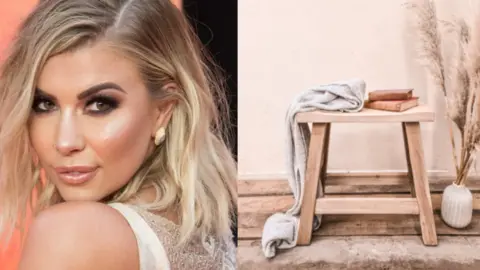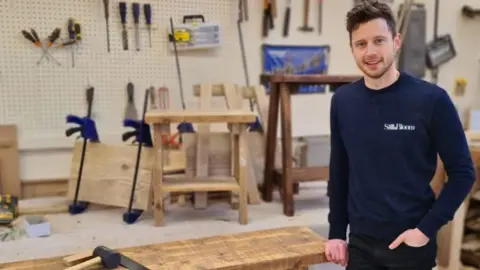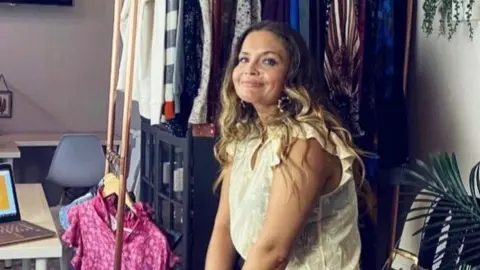The influencer effect: 'Love Island star transformed my business'
 Getty Images/Nick Fisher
Getty Images/Nick FisherSay the word "influencer" and you may well hear audible groans - they don't always enjoy the best of reputations. However for some people, influencer work has been a lifeline during the pandemic.
Nick Fisher's Hampshire-based furniture business Still & Bloom has suffered since Covid struck. Most of his clients were in the now-beleaguered hospitality and retail sectors.
So in November 2020 he decided to try to shift the business to a different market, and set up a small online presence, with a page on the craft sales platform Etsy and 54 followers on Instagram. One or two orders per week trickled in.
Then one evening last month someone told him the Love Island star Olivia Bowen had posted a picture about a new purchase on an interior design Instagram account she ran, and it looked like his furniture, although he was not tagged in it.
"I'd seen her name in our orders, but I hadn't twigged. My wife said, 'you have to message her!'" Nick recalls, admitting Love Island was "a guilty pleasure" so the pair knew who the star was.
"I said, 'I can't do that!' She said the worst Olivia could do would be to not respond."
 Nick Fisher
Nick FisherTaking his wife's advice turned out to be a massive turning point for Nick's business.
Not only did Olivia Bowen reply, she offered to make a video of the product, and this time included the name of Nick's firm in the resulting post.
"The phone didn't stop vibrating for two days. We went up to 2,500 followers in 24 hours and the product she bought became one of our best sellers. We couldn't make them quick enough," he says.
She had found him online completely by chance.
Nick has since had other influencers on the phone, including two professional golfers and another reality TV star. In addition, Ms Bowen has placed further orders - and, contrary to popular belief about influencers, nobody has asked for any freebies.
Nick is now getting several sales orders a day from Instagram.
What happened to him could be described as an exceptional stroke of good fortune - he has not paid for any of his new-found influencer engagement - but he says he thinks the influencers deserve their fees.
"If you have one million followers that is a full-time job, and it's stressful. Anyone can message you anything they want, it's all consuming. It's only fair that they should be able to earn some sort of income from it. It provides a huge service to everyone," he says.
But if you are paying, how do you measure whether you're getting your money's worth?
Return on investment
Ben Jeffries runs the marketing agency influencer.com. He says on average, brands are likely to spend between £40,000 and £100,000 on influencer marketing, and there are various ways for them to track a campaign's success.
 Getty Images
Getty ImagesHis firm calculates an "impact score" which takes into consideration a number of factors, including how many people share a post or click through to a website, and he also analyses exactly what is said in the comments - whether they are positive or negative about the brand, or reveal an intention to purchase.
He believes it is misleading to rely on the number of likes or comments a post gets alone.
"Likes and comment numbers no longer cut it," he says.
"We believe success is measured in much deeper metrics."
Mr Jeffries also says it is a mistake to think that only people with an enormous number of followers can be successful influencers.
"It's important to just look at that top level follower number - but you also have to understand the authenticity, what sort of relationship the creator has with their audience," he says.
"Is it the case that they're regularly posting, are they deeply engaged? All these metrics help you understand what ROI [return on investment] you might get.
"What you tend to find is creators with smaller (numbers of) followers are able to be more deeply engaged as there's a smaller community for them to respond to."
The rise of the micro-influencer
Donna McCulloch has just started working as a micro-influencer - she is a fashion stylist who has now completed her two influencer campaigns.
 Donna McCulloch
Donna McCullochShe admits that she was nervous about the impact of influencer work on her credibility in the fashion industry, but like many others the pandemic has forced her to think differently about work, and she could see that her peers were also starting to do it.
Donna reached 10,000 followers on Instagram last year and said that was the point at which she became more attractive to brands.
"They look for your engagement level and a loyal following," she says.
And the work itself can be time consuming.
"They usually expect a grid post, some stories or reels, they like it to go in your highlights or on your Instagram TV.
"It feels great when the brand comes back to you and says thanks, the product is flying off the shelves," she said.
However she has already turned down brands that did not feel like "the right fit", including one firm whose other influencers were all young reality stars (Donna is a working mother in her 40s), and wanted to pay her primarily in the form of gifting her the product.
"If they'd offered me a lot more money maybe I would have thought about it," she says.
"But I didn't think we were right for each other."
Listen to Nick Fisher, Ben Jeffries and Donna McCulloch talk about their influencer experiences on BBC Tech Tent.
